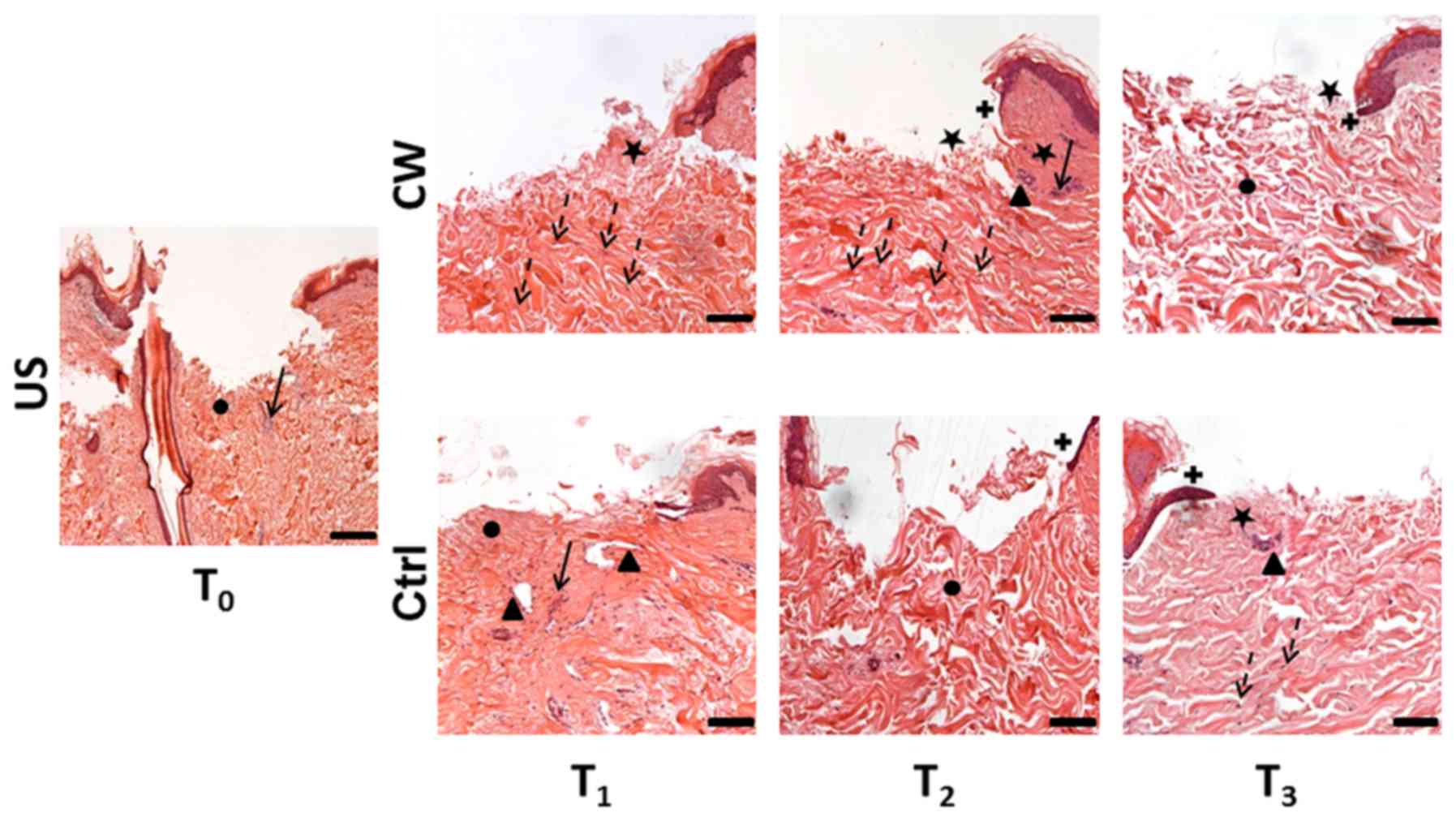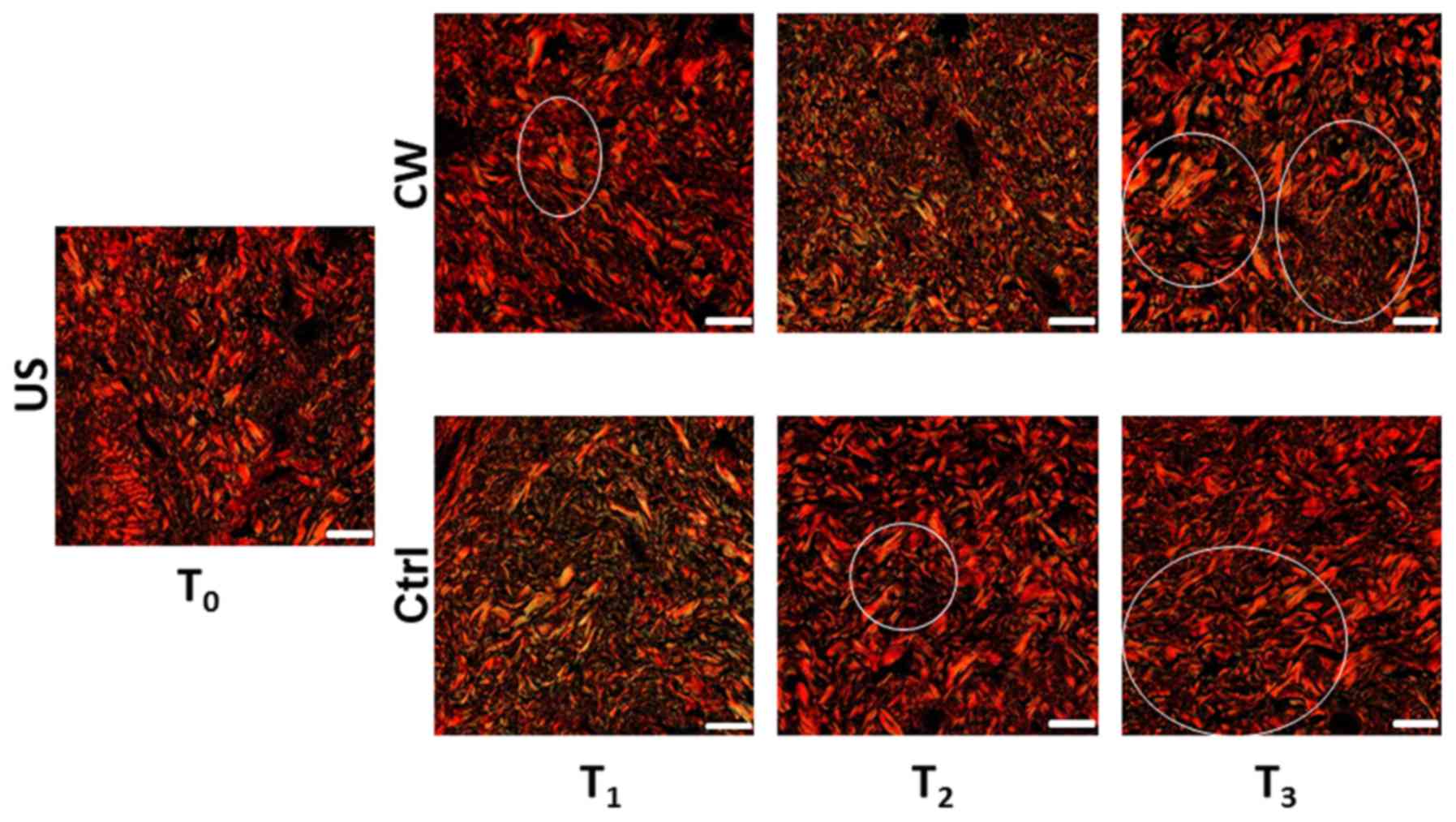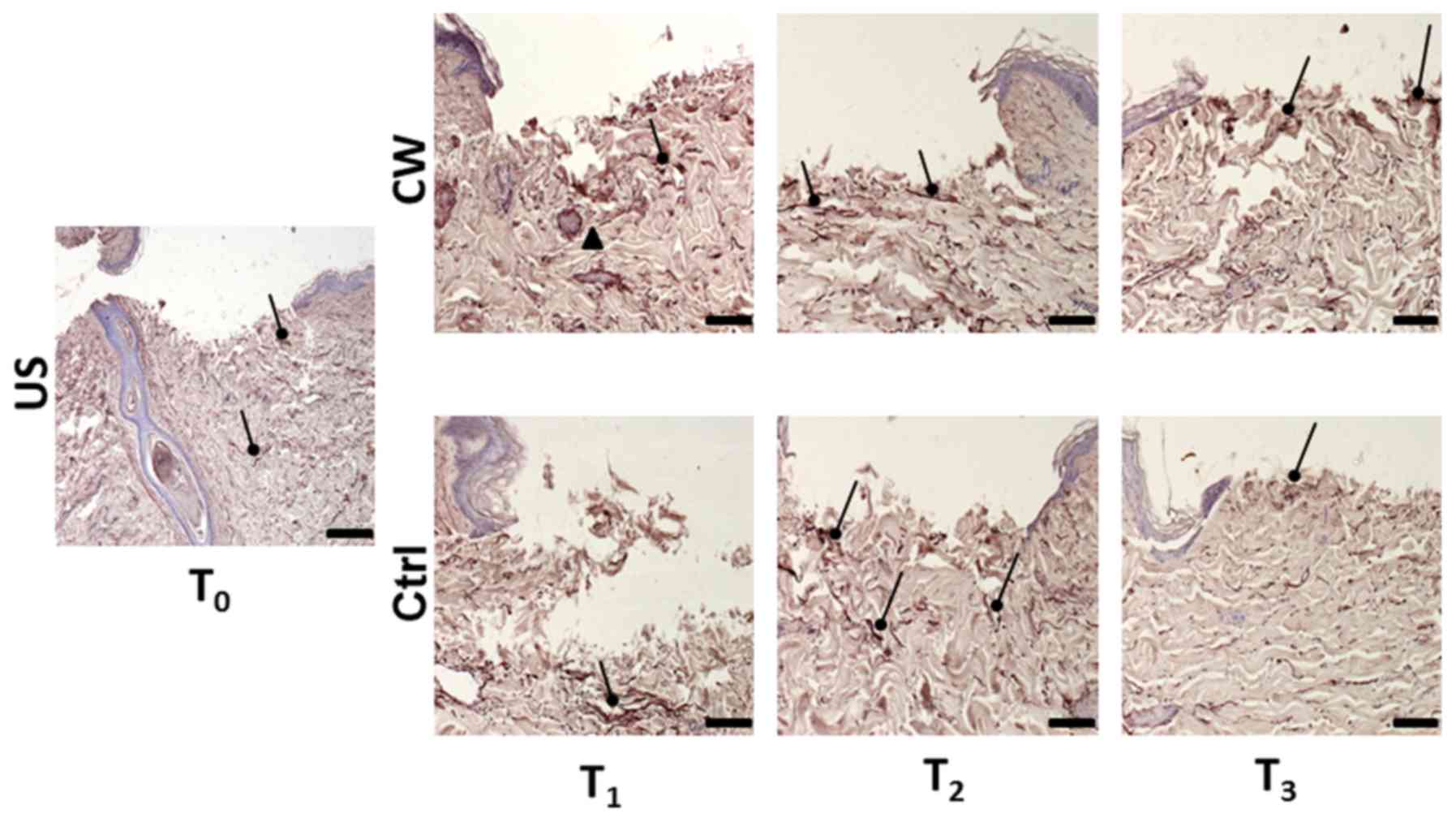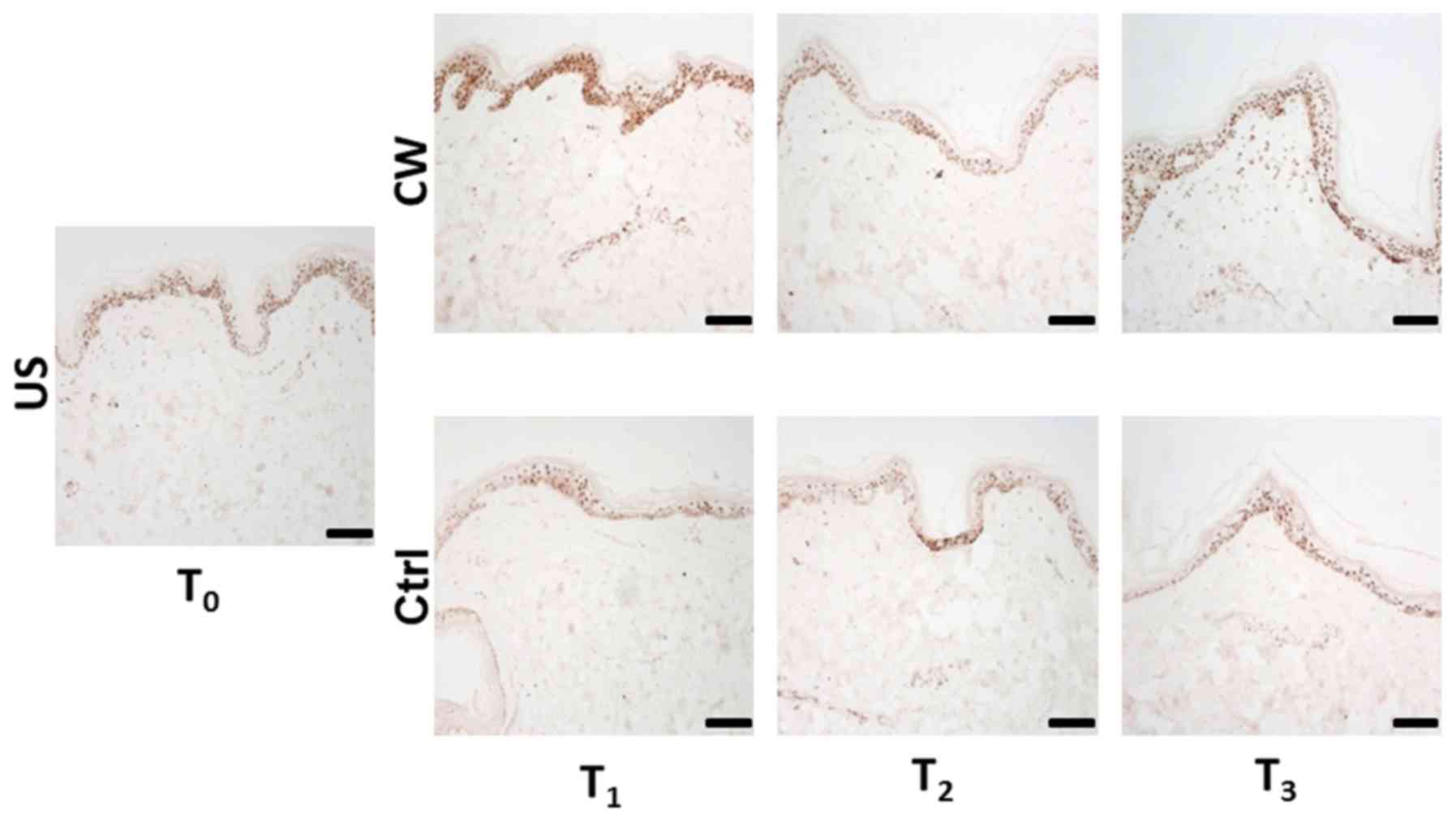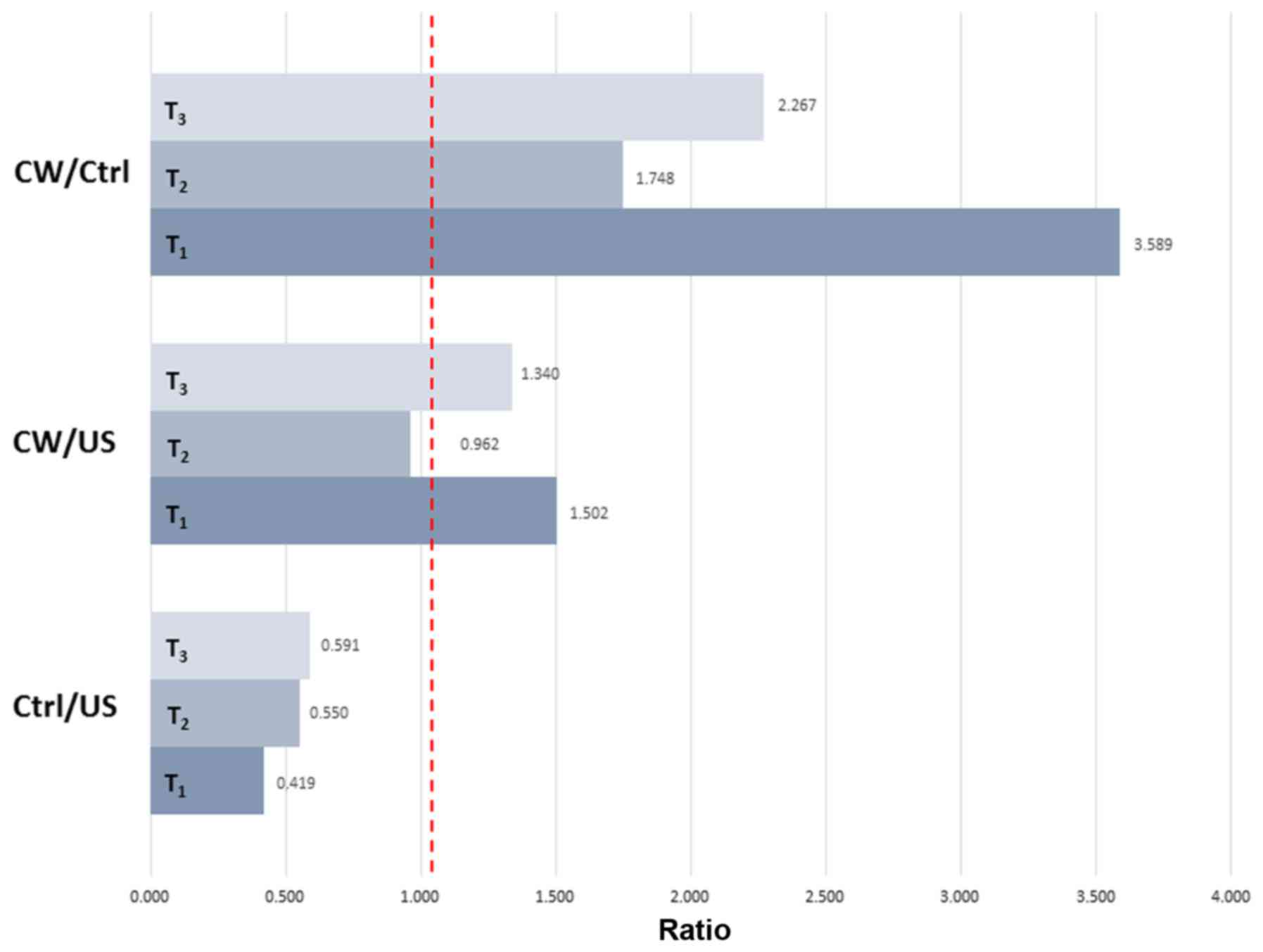Ex vivo regenerative effects of a spring water
- Authors:
- Published online on: October 18, 2017 https://doi.org/10.3892/br.2017.1002
- Pages: 508-514
-
Copyright: © Nicoletti et al. This is an open access article distributed under the terms of Creative Commons Attribution License.
Abstract
Introduction
The role of microbiota in controlling the balance between health and disease is a current topic of study due to its potential to be used for novel therapeutic approaches (1). In particular, the local application of bacteria to enhance wound healing has previously been reported (2,3). These favorable effects may be related, though not exclusively, to certain anti-inflammatory and antibiotic actions of bacteria.
Previous experiments by our group have indicated that the Italian calcium magnesium bicarbonate-based Comano spring water (Comano, Italy) improves skin regeneration: In an in vivo rabbit wound model, it was identified that the topical administration of the Comano spring water increased keratinocyte proliferation and migration, and favorably modulated the regeneration of dermal collagen and elastic fibers (4); while in in vitro cultures of human skin fibroblasts, it was observed that cells maintained in conventional Dulbecco's modified Eagle's medium (DMEM) with 20% Comano spring water exhibited a 31% higher vitality than control cells maintained in conventional DMEM alone after 72 h (5).
Other studies have demonstrated the anti-inflammatory effect of the spring waters of Avène and La Roche-Posay in France, effective in activating toll-like receptors due to the specific actions of the non-pathogenic bacteria Aquaphilus dolomiae (6) and Vitreoscilla filiformis (7), respectively. The Comano spring water also exhibits a diverse non-pathogenic bacterial flora (8,9). To further investigate the regenerative effects of the native bacterial flora of the Comano spring water, the present study evaluated the efficacy of spring water treatment in a human ex vivo model of physiological wound healing. The study was performed at the Plastic Surgery Unit in the Department of Clinical-Surgical, Diagnostic and Pediatric Sciences, in cooperation with the Histology and Embryology Unit in the Department of Public Health, Experimental and Forensic Medicine at the University of Pavia (Pavia, Italy). The results of the current research may aid the development of novel clinical approaches for tissue regeneration and wound healing within the modern concept of ‘natural’ medicine. Additionally, they may provide novel scientific data on thermalism and indicate its therapeutic use with a rational basis.
Materials and methods
Spring water collection and processing
Comano spring water was collected in January 2014 from the Comano spring by an aseptic procedure. Briefly, a single operator wearing sterile surgical gloves collected 3,000 ml water with a sterile 60-ml syringe.
The samples were poured into three sterile 1-L containers, stored at 4°C and transported to the Histology and Embryology Unit of the University of Pavia (Pavia, Italy). After 2 days, the spring water was filtered through 0.20-µm pore cellulose nitrate membranes (Nalgene 0.2 Analytical Filter Units; Thermo Fisher Scientific, Inc., Waltham, MA, USA), stored at 4°C in sterile 100 ml ampoules and used as described below. All ex vivo experiments were performed within 3 months of water filtration and storage.
Human skin specimen collection
Human skin samples were obtained from anatomical specimens harvested during sessions of elective abdominoplasty or reduction mammoplasty performed on 6 healthy female patients (age range, 43–56 years). The specimens were sampled by a surgeon in ~6×6-cm segments and conserved in sterile containers filled with saline solution enriched with 1% (10,000 U/ml) penicillin (Biowest, Nuaillé, France), then transported to a partner laboratory for further processing. The time delay between tissue harvesting and the initiation of laboratory procedures was ~45 min. The study was conducted in accordance with the 1975 Declaration of Helsinki, informed consent was obtained from all patients and the protocol was approved by the Ethics Committee of Salvatore Maugeri Research and Care Institute, Pavia, Italy (project identification code, 2064).
Human skin specimen processing
The skin samples were sufficient for the harvesting of 6 mm-punch biopsies that in turn were injured in their central portion with a sterile 3-mm circular punch to establish skin loss in each sample as described previously (10–12). The injured specimens were placed into Transwell inserts for 24-well multiwell plates (membrane pore size, 0.40 µm; Constar insert, 0.33 cm2; Corning Incorporated, Corning, NY, USA).
Study design
Each of the 6 skin specimens was used to harvest paired control and experimental samples. The control samples were cultured in DMEM with 1.0 g/l D-glucose (Biochrom, Ltd., Cambridge, UK), 10% fetal bovine serum (FBS), 1% penicillin (10,000 U/ml) and streptomycin (10 mg/ml), 1% gentamicin (all from Biowest) and 10 ml/l 200 mM L-glutamine (Eurobio Laboratoires, Les Ulis, France), and the central skin loss region was treated with a constant volume (200 µl) of sterile saline solution.
The samples treated with Comano spring water (treated samples) were cultured with DMEM powder without NaHCO3 with 1.0 g/l D-glucose (Biochrom, Ltd.) and 10 ml/l 200 mM L-glutamine, reconstituted with filtered Comano spring water and enriched with 10% FBS, 1% penicillin (10,000 U/ml) and streptomycin (10 mg/ml) and 1% gentamicin (all from Biowest). The central skin loss region was treated with a constant volume (200 µl) of filtered Comano spring water. Following treatment, the control and treated samples were incubated at 37°C for 24, 48 and 72 h.
Assessment modalities
Morphological analysisMorphological analysis of the specimens was performed by two independent operators at 0 h (T0) to identify the histological features of the untreated skin (US) and at 24, 48 and 72 h thereafter (T1–3) to identify the features of the skin in the different experimental groups.
The skin specimens were fixed with 4% paraformaldehyde in phosphate buffer (pH 7.4) for 8 h at 4°C, dehydrated through graded concentrations of ethanol and embedded in paraffin. Subsequently, 7.5-µm specimen sections were obtained with a microtome, rehydrated and stained by different methods.
Hematoxylin and eosin (H&E) staining was performed with Harry's hematoxylin for 5 min and eosin for 30 sec (Bio-Optica SpA, Milan, Italy) at room temperature. The stained sections were observed with a Zeiss Axiophot microscope (Carl Zeiss AG, Oberkochen, Germany) in bright field. The assessment of specimens by optical microscopy following H&E staining focused on features of the collagen fiber network, cellular infiltration and the re-epithelialization process.
Staining for collagen fibers was performed with a modified Picrosirius Red (Sigma-Aldrich; Merck KGaA, Darmstadt, Germany) procedure (13,14). In brief, following rehydration, the sections were incubated for 1 h at room temperature in 0.1% Sirius Red in a saturated picric acid solution, and then washed twice in 1% acetic acid for 15 sec. This was followed by staining with hematoxylin for 5 min at room temperature, rinsing in water for 5 min, dehydration and mounting of the slides with DPX (Sigma-Aldrich; Merck KGaA). The sections were then examined under polarized light with the Zeiss Axiophot microscope equipped with a polarizing filter.
Elastic fibers were stained with orcein staining reagents (Bio-Optica SpA) according to the manufacturer's protocol. Following rehydration, the sections were treated with 5 drops of potassium permanganate solution (reagent A) and 5 drops of acid activation buffer (reagent B) for 4 min. After washing with distilled water, the sections were treated with 10 drops of oxalic acid solution (reagent C) for 1 min, and then washed with distilled water. Subsequently, 20 drops of alcoholic reagent (reagent D) were placed onto the bottom of an incubation box, the sections were introduced into the box, and each section was treated with 10 drops of orcein solution (reagent E) for 20 min. Following washing with distilled water, the sections were treated with 10 drops of differentiation solution (reagent F) for 2 min. Finally, the sections were stained with hematoxylin for 5 min at room temperature, washed in water for 5 min, dehydrated, mounted and observed with the Zeiss Axiophot optical microscope.
Staining for proliferating cell nuclear antigen (PCNA) was used to quantify the cell turnover rates of the different culture groups. The sections were treated with 0.3% hydrogen peroxide for 30 min at room temperature to block endogenous peroxidase activity, and then were immersed in a citrate buffer and treated for antigenic retrieval with steam for 30 min, which was followed by blocking of non-specific sites with Background Sniper reagent (Biocare Medical, LLC, Pacheco, CA, USA) for 10–15 min at room temperature.
The sections were then incubated with primary mouse anti-PCNA antibody overnight at 4°C (1:4,500; cat. no. 152; Biocare Medical, LLC), then with MACH 1 mouse probe for 15 min and Horseradish Peroxidase (HRP)-Polymer for 30 min (MACH1 Universal HRP-Polymer Detection system; Biocare Medical, LLC), according to the manufacturer's instructions. Following incubation with betazoid diaminobenzidine (Biocare Medical, LLC) for 5 min at room temperature, the sections were dehydrated, mounted with DPX mounting medium and examined. Between each the immunostaining steps, the sections were washed with 0.15 M Tris-buffered saline, pH 7.4 (0.05 M Tris buffer containing 0.1 M sodium chloride). The observations were performed with the Zeiss Axiophot optic microscope equipped with a Nikon Digital Sight DS-5M camera (Nikon Corporation, Tokyo, Japan). Positive nuclei were counted in all fields of view for each section by the same two independent operators at the different time points.
Data analysisData processing and analysis was performed for the PCNA counts. The mean count of the two independent operators' values was calculated. The mean value of the two measurements on the same sample was estimated for each experimental condition and time point. The ratio between the mean values of the samples cultured under the different experimental conditions (Comano water/control) was also calculated at each time point.
Results
H&E staining
Collagen fibersAt T1 the control samples exhibited absence of the papillary dermis and a compact and regular arrangement of collagen fibers in the reticular dermis. A newly formed loose unstructured connective tissue was also observed. At T2 the fibers had increased in size and compactness, and exhibited an orientation perpendicular to the skin surface. At T3 the fibers appeared smaller in size compared with T2, while their orientation had become parallel to the skin surface (Fig. 1).
At T1 the treated samples exhibited a regenerated regular papillary dermis and a structured reticular dermis comprised of collagen fibers with a slight perpendicular orientation to the skin surface. At T2 some active regeneration in the papillary dermis was observed, and the collagen fibers in the reticular dermis exhibited regular structure with a more parallel orientation to the skin surface. At T3 the papillary dermis exhibited an active regeneration similar to that at T2; the collagen fibers in the reticular dermis exhibited regular structure, though their orientation had become more irregular, which was concomitant with an increase in interfiber spaces (Fig. 1).
Cellular infiltrationInflammatory cell infiltration was detected around the newly formed vascular structures. In the control samples at T1, increased inflammatory infiltration was observed compared with the US samples. This infiltration progressively decreased in the T2 and T3 samples. In the treated samples, inflammatory infiltration was absent at T1 and T3, while at T2, slight infiltration similar to that in the US was observed.
In the control samples at T1, some fibroblasts were observed in the dermis, which were markedly reduced by T3. Conversely, in the treated samples, few fibroblasts were observed in the dermis at T1, while increased fibroblasts were observed by T3 (Fig. 1).
Re-epithelializationThe control samples lacked re-epithelialization at T1, though exhibited early basal cell re-epithelialization at T2 and signs of multi-layered re-epithelialization at T3 (Fig. 1).
In the treated samples, a similar sequence of re-epithelialization was observed, with absence of re-epithelialization at T1, early single-layered re-epithelialization at T2, and multi-layered re-epithelialization at T3 (Fig. 1).
Picrosirius Red stainingAt T1, the control samples exhibited diffuse green-yellow birefringence suggestive of early collagen fiber regeneration. At T2, a red birefringence was observed, indicating a reduction in the collagen regeneration process. This remained stable at T3 (Fig. 2).
At T1, the treated samples exhibited some green birefringence. At T2, this developed into a diffuse green-yellow birefringence. At T3, regions of green-yellow birefringence were observed (Fig. 2).
Orcein stainingAt T1, the control samples exhibited diffuse staining and a slight parallel orientation of elastic fibers to the skin surface. At T2, a reduction in staining was observed, and the orientation of the elastic fibers had become more perpendicular to the skin surface. Further reduced staining was observed at T3 and fiber distribution was similar to that in the US, with the fibers reverted to a more parallel orientation (Fig. 3).
At T1, the treated samples exhibited diffuse staining and an irregular orientation of the elastic fibers to the skin surface. At T2, a marked parallel orientation of the elastic fibers to the skin surface was observed, and the elastic fibers were concentrated between the papillary and reticular dermis. This concentration of fibers remained stable at T3, though both perpendicular and parallel orientations were observed. Fiber distribution throughout the dermal layers also became similar to that of the US (Fig. 3).
PCNA stainingAt T1, the control samples exhibited a reduction in the number of PCNA-positive nuclei compared with the US stained at T0. At T2, compared with T1, a slight increase in the PCNA-positive nuclei count was observed; however, the number of positive nuclei remained lower than in the US. At T3, a stable positive nuclei count compared with T2 was exhibited.
At T1, the treated samples exhibited a notable increase in the count of PCNA-positive nuclei compared with the US at T0. At T2, the PCNA-positive nuclei count was markedly decreased compared with that at T1 and slightly reduced compared with the US. At T3, the positive nuclei count was increased compared with that at T2 and somewhat higher than that in the US. Additionally, the treated samples exhibited increased counts of PCNA-positive nuclei compared with the control samples, notably at T1 and T3 (Fig. 4).
The ratio of PCNA-positive nuclei between the treated and control samples decreased from T1 to T2 and increased from T2 to T3. A similar trend was observed for the ratio between the treated and US samples, although at lower values. The ratio between the controls and US underwent progressive marginal increases from T1 to T3 (Fig. 5).
Discussion
In the present study an ex vivo human skin model was used to evaluate the physiology of human skin during the wound repair process.
A number of strategies that have used skin samples of differing thickness, different types of culture media and different platforms for support have previously been used to maintain full-skin culture ex vivo (10). The model used in the current study was based on full-thickness skin punch biopsies containing a central skin loss injury that were cultured in DMEM, of which the reliability and effectiveness for reproducing the human skin physiology in previous research trials have been indicated (11,12).
A previous study by our group on a rabbit wound healing model in vivo demonstrated a significant increase in overall keratinocyte proliferation and a corresponding reduction in the local inflammatory response following application of Comano spring water (4). These results were further supported by our previous study of human skin fibroblast cultures in vitro (5). Previous data suggests that the bioactive effects of some spring waters may be correlated not only to their specific mineral composition, but also to the complex activity of the resident non-pathogenic bacterial flora, of which the composition and biological features are largely unknown at present (6,7).
The spring waters certified as bacteriologically pure are considered to be best termed as pathogen germ-free (15). In the Comano spring water, a total of 12 different bacterial strains have recently been identified (Aeromonas encheleia, Aeromonas hydrophila, Bacillus simplex, Brevundimonas vesicularis, Chromobacterium violaceum, Citrobacter youngae, Cupriavidus campinensis, Empedobacter brevis, Pantoea agglomerans, Pseudomonas putida, Pseudomonas stutzeri and Streptococcus mitis) (8). All of these bacterial strains, despite showing a rare potential virulence, demonstrate overall favorable metabolic activity that includes the ability to promote water self-purification (16), to degrade soil contaminants such as herbicides, pesticides and organic solvents (17–20), and to produce antifungi, antibacterial and antioxidant substances (21–24). The presence of other unknown bacterial species is also being demonstrated by ongoing genomic sequential analysis (9). Therefore, the overall non-pathogenic bacterial populations of the Comano spring water, comprehensively termed microbiota, may be responsible for its regenerative properties. These properties may be related to the production of so far unknown substances that promote regeneration, probably in synergy with macro and micro mineral elements of the spring water (25).
In the present study, filtered Comano spring water was used to obtain germ-free water that retained the supposed bioactive bacterial metabolites (26). Investigations into the Comano spring water microbiota by our group are now focusing on the extraction of bacterial lysates from the bacterial strains considered most influential, and a forthcoming study plans to assess their regenerative properties on the experimental model used in the current study.
In the present experimental model, control skin biopsies were cultured with DMEM and saline solution was applied to the central skin loss region. The biological events that occurred over the 72 h observation period paralleled histological features previously observed for an ex vivo human skin model, whereby the absence of re-epithelialization and a rich inflammatory cell infiltrate with progressive late identification of fibroblasts were documented (27).
The current study identified favorable biological events in the human skin samples treated with filtered Comano spring water. The most notable effects were evident in the dermis. A markable anti-inflammatory effect by reducing overall dermal cell infiltration when compared with the controls was appreciated. The reduction in cellular infiltrate in the dermis was concomitant with fibroblast recruitment, suggesting a favorable modulation of the local cell proliferative phase.
The PCNA immunostaining demonstrated a notable stimulation of cell proliferation in the samples treated with Comano spring water compared with the controls; the samples treated with the spring water not only failed to exhibit the expected reduction in cellular vitality following tissue explantation, but also exhibited an increase in cell proliferation compared with the baseline skin values. Most notably, cell proliferation appeared highest in the treated samples at T1 and T3 when compared with the US at T0. Considering a ratio equal to 1 is the condition for no difference between the experimental conditions, and that only the treated samples exhibited a ratio >1, this indicates a regenerative capacity of Comano spring water.
A regenerative process was also indicated by an increase in papillary dermis in the treated samples compared with the controls.
Although the observation time of 72 h was relatively short, interesting effects following the application of filtered spring water were observed in the dermal collagen fiber network. Signs of collagen fiber degeneration were appreciated at a later time (T3) than in the controls, with an increase in matrix deposition, and an increase in the spaces amongst the fibers. The selective green staining with Picrosirius Red, indicative of active collagen fiber regeneration through the production of small-sized collagen fibers (28), suggested an early regenerative activity in the treated samples, that, despite fading by T3, remained higher than in the control samples. A similar trend was observed for the elastic fiber network, which exhibited signs of regeneration in the treated samples throughout the observation period.
In conclusion, the previously implicated regenerative properties of the Comano spring water were confirmed in the current ex vivo human skin wounding model. Reduction of inflammatory cell infiltration with selective fibroblast recruitment was identified following application of the Comano spring water. These favorable cellular effects matched an increase in neo-collagen synthesis and a stimulatory effect on elastic fiber regeneration. All of these effects are potentially associated with the functions of the active metabolites produced by the spring water's native microbiota. Thus, preparations of the spring water, as a natural remedy, may have clinical efficacy in promoting tissue regeneration and wound healing.
Acknowledgements
The present study was partially funded by ALMaUST Onlus, Milano, Italy (grant no. 1514), Istituto GB Mattei, Terme di Comano, Stenico, Italy (grant no. 24147) and Fondazione Anna Villa e Felice Rusconi Onlus, Varese, Italy (grant no. 24988). Professor Angela Faga and Dr Giovanni Nicoletti designed the experiments, analyzed the data and wrote the paper; Dr Marco Saler and Dr Federica Riva performed the experiments; Dr Alberto Malovini analyzed the data; Dr Tommaso Pellegatta, Dr Marco Mario Tresoldi and Dr Viola Bonfanti contributed to the data collection and analysis and paper writing. The authors wish to thank Dr Laura Villani at the Maugeri Clinical Scientific Institutes for her help in reviewing and interpreting the histological preparations.
References
|
Belizário JE and Napolitano M: Human microbiomes and their roles in dysbiosis, common diseases, and novel therapeutic approaches. Front Microbiol. 6:10502015. View Article : Google Scholar : PubMed/NCBI | |
|
Kanno E, Kawakami K, Ritsu M, Ishii K, Tanno H, Toriyabe S, Imai Y, Maruyama R and Tachi M: Wound healing in skin promoted by inoculation with Pseudomonas aeruginosa PAO1: The critical role of tumor necrosis factor-α secreted from infiltrating neutrophils. Wound Repair Regen. 19:608–621. 2011. View Article : Google Scholar : PubMed/NCBI | |
|
Kostarnoy AV, Gancheva PG, Logunov DY, Verkhovskaya LV, Bobrov MA, Scheblyakov DV, Tukhvatulin AI, Filippova NE, Naroditsky BS and Gintsburg AL: Topical bacterial lipopolysaccharide application affects inflammatory response and promotes wound healing. J Interferon Cytokine Res. 33:514–522. 2013. View Article : Google Scholar : PubMed/NCBI | |
|
Faga A, Nicoletti G, Gregotti C, Finotti V, Nitto A and Gioglio L: Effects of thermal water on skin regeneration. Int J Mol Med. 29:732–740. 2012.PubMed/NCBI | |
|
Nicoletti G, Saler M, Pellegatta T, Malovini A, Faga A, Scalise A and Riva F: Effects of a spring water on human skin fibroblasts in vitro cultures: Preliminary results. Acta Vulnol. 14:196–201. 2016. | |
|
Aries MF, Fabre P, Duplan H, Hernandez Pigeon H, Galliano MF, Castex-Rizzi N, Bessou-Touya S and Nguyen T: I-modulia, an Aquaphilus dolomiae extract, stimulates innate immune response through Toll-like receptor activation. J Am Acad Dermatol. 70 Suppl 1:AB632014. View Article : Google Scholar | |
|
Mahe YF, Perez MJ, Tacheau C, Fanchon C, Martin R, Rousset F and Seite S: A new Vitreoscilla filiformis extract grown on spa water-enriched medium activates endogenous cutaneous antioxidant and antimicrobial defenses through a potential Toll-like receptor 2/protein kinase C, zeta transduction pathway. Clin Cosmet Investig Dermatol. 6:191–196. 2013.PubMed/NCBI | |
|
Nicoletti G, Corbella M, Jaber O, Marone P, Scevola D and Faga A: Non-pathogenic microflora of a spring water with regenerative properties. Biomed Rep. 3:758–762. 2015. View Article : Google Scholar : PubMed/NCBI | |
|
Jousson O: Culture-independent versus culture-dependent approaches for microbial community analysis of a thermal spring with therapeutic propertiesEMBL Symposium Heidelberg. New Approaches and Concepts in Microbiology; Germany: June 27–30–2017 | |
|
Nakamura M, Rikimaru T, Yano T, Moore KG, Pula PJ, Schofield BH and Dannenberg AM Jr: Full-thickness human skin explants for testing the toxicity of topically applied chemicals. J Invest Dermatol. 95:325–332. 1990. View Article : Google Scholar : PubMed/NCBI | |
|
Mori M, Rossi S, Ferrari F, Bonferoni MC, Sandri G, Riva F, Tenci M, Del Fante C, Nicoletti G and Caramella C: Sponge-like dressings based on the association of chitosan and sericin for the treatment of chronic skin ulcers. II. Loading of the hemoderivative platelet lysate. J Pharm Sci. 105:1188–1195. 2016. View Article : Google Scholar : PubMed/NCBI | |
|
Fontana F, Mori M, Riva F, Mäkilä E, Liu D, Salonen J, Nicoletti G, Hirvonen J, Caramella C and Santos HA: Platelet lysate-modified porous silicon microparticles for enhanced cell proliferation in wound healing applications. ACS Appl Mater Interfaces. 8:988–996. 2016. View Article : Google Scholar : PubMed/NCBI | |
|
Junqueira LCU, Bignolas G and Brentani RR: Picrosirius staining plus polarization microscopy, a specific method for collagen detection in tissue sections. Histochem J. 11:447–455. 1979. View Article : Google Scholar : PubMed/NCBI | |
|
Montes GS and Junqueira LC: The use of the Picrosirius-polarization method for the study of the biopathology of collagen. Mem Inst Oswaldo Cruz. 86 Suppl 3:1–11. 1991. View Article : Google Scholar : PubMed/NCBI | |
|
Éditeur officiel du Québec: Regulation respecting bottled water. Food Products Act. Chapter P-29, s. 40. http://www.legisquebec.gouv.qc.ca/en/pdf/cr/S-2.1,%20R.%2013.pdfApril 24–2017 | |
|
Kompanets EV, Isaeva NM and Balakhnin IA: Bacteria of the genus Aeromonas and their role in aquaculture. Mikrobiol Zh. 54:89–99. 1992.(In Russian). PubMed/NCBI | |
|
Erguven GO and Yildirim N: Efficiency of some soil bacteria for chemical oxygen demand reduction of synthetic chlorsulfuron solutions under agiated culture conditions. Cell Mol Biol (Noisy-le-grand). 62:92–96. 2016.PubMed/NCBI | |
|
Han L, Zhao D and Li C: Isolation and 2,4-D-degrading characteristics of Cupriavidus campinensis BJ71. Braz J Microbiol. 46:433–441. 2015. View Article : Google Scholar : PubMed/NCBI | |
|
Cheriaa J, Mosrati R, Ladhari N and Bakhrouf A: Acclimated biomass that degrades sulfonated naphthalene formaldehyde condensate. Pak J Biol Sci. 11:1588–1593. 2008. View Article : Google Scholar : PubMed/NCBI | |
|
Li C, Yang J, Wang X, Wang E, Li B, He R and Yuan H: Removal of nitrogen by heterotrophic nitrification-aerobic denitrification of a phosphate accumulating bacterium Pseudomonas stutzeri YG-24. Bioresour Technol. 182:18–25. 2015. View Article : Google Scholar : PubMed/NCBI | |
|
El Amraoui B, El Amraoui M, Cohen N and Fassouane A: Antifungal and antibacterial activity of marine microorganisms. Ann Pharm Fr. 72:107–111. 2014. View Article : Google Scholar : PubMed/NCBI | |
|
Durán M, Faljoni-Alario A and Durán N: Chromobacterium violaceum and its important metabolites - review. Folia Microbiol (Praha). 55:535–547. 2010. View Article : Google Scholar : PubMed/NCBI | |
|
Hoshino T: Violacein and related tryptophan metabolites produced by Chromobacterium violaceum: Biosynthetic mechanism and pathway for construction of violacein core. Appl Microbiol Biotechnol. 91:1463–1475. 2011. View Article : Google Scholar : PubMed/NCBI | |
|
Rezzonico F, Smits TH, Montesinos E, Frey JE and Duffy B: Genotypic comparison of Pantoea agglomerans plant and clinical strains. BMC Microbiol. 9:2042009. View Article : Google Scholar : PubMed/NCBI | |
|
Pellegatta T, Saler M, Bonfanti V, Nicoletti G and Faga A: Novel perspectives on the role of the human microbiota in regenerative medicine and surgery. Biomed Rep. 5:519–524. 2016. View Article : Google Scholar : PubMed/NCBI | |
|
Liang Z and Keeley A: Filtration recovery of extracellular DNA from environmental water samples. Environ Sci Technol. 47:9324–9331. 2013. View Article : Google Scholar : PubMed/NCBI | |
|
Safferling K, Sütterlin T, Westphal K, Ernst C, Breuhahn K, James M, Jäger D, Halama N and Grabe N: Wound healing revised: A novel reepithelialization mechanism revealed by in vitro and in silico models. J Cell Biol. 203:691–709. 2013. View Article : Google Scholar : PubMed/NCBI | |
|
Xu W, Jong Hong S, Jia S, Zhao Y, Galiano RD and Mustoe TA: Application of a partial-thickness human ex vivo skin culture model in cutaneous wound healing study. Lab Invest. 92:584–599. 2012. View Article : Google Scholar : PubMed/NCBI |



